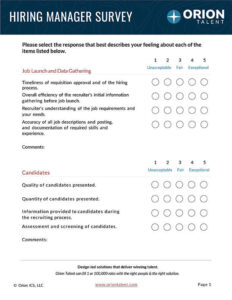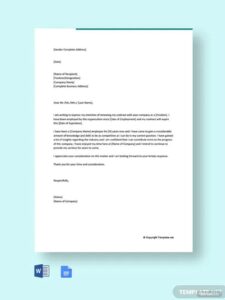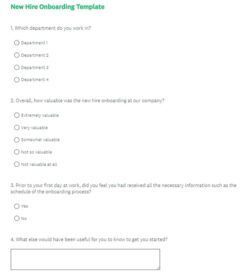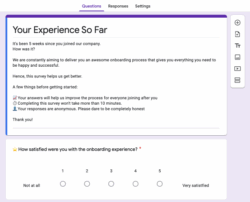Bringing new talent into your team is an exciting time, but the journey doesn’t end with a signed offer letter. The period immediately following a new employee’s start date, known as onboarding, is absolutely critical for their long-term success and satisfaction within your organization. It’s during this time that they form their first impressions, understand their role, and begin to integrate into the company culture. Ensuring this process is smooth, informative, and welcoming is paramount to retaining your valuable hires.
However, how do you really know if your onboarding process is hitting the mark? This is where a well-designed new hire onboarding survey template comes into play. It’s your secret weapon for gathering candid, actionable feedback directly from your newest team members. By systematically asking the right questions, you can identify what’s working beautifully, pinpoint areas that need improvement, and ultimately refine your onboarding experience to make every new employee feel valued, prepared, and excited about their role.
Crafting the Perfect Onboarding Survey: Key Areas to Cover
Creating an effective onboarding survey isn’t just about throwing a few questions together. It’s about strategically assessing every touchpoint of the new hire experience, from pre-start communications to their integration into the team. A comprehensive survey should cover various stages and aspects to give you a holistic view of the process from the new employee’s perspective. Think about the journey they take and where you can gather insights.
You’ll want to touch on the initial interactions even before day one. Was the paperwork clear? Were they given enough information about their first day? This pre-boarding phase sets the tone and can significantly impact a new hire’s anxiety levels and excitement. Getting this right means they arrive feeling prepared and welcomed, not overwhelmed.
Next, focus on their first few days and weeks. How was their workstation setup? Were introductions made effectively? Did they feel supported by their manager and colleagues? This period is often a whirlwind of new information, and ensuring they have the tools and support to navigate it is crucial. Clarity around their role, expectations, and immediate tasks also falls into this important early phase.
Beyond the initial setup, consider the ongoing support, training, and cultural integration. Are the training programs effective and relevant? Do they feel like they have opportunities to ask questions and learn? Is the company culture inclusive and welcoming? These elements contribute to a new hire’s long-term engagement and decision to stay.
Essential Sections for Your Survey
- **Pre-boarding and First Impressions:**
- Was the communication prior to your start date clear and helpful?
- Did you feel prepared for your first day?
- How was your experience with paperwork and administrative tasks?
- **Role Clarity and Resources:**
- Do you clearly understand your role and responsibilities?
- Were you provided with the necessary tools and resources to do your job effectively?
- How effective was the initial training you received?
- **Manager and Team Support:**
- Did your manager provide sufficient support and guidance during your first few weeks?
- Did you feel welcomed by your team and colleagues?
- Have you had opportunities to connect with team members?
- **Company Culture and Integration:**
- How well do you feel you understand the company’s mission and values?
- Do you feel included in team activities and discussions?
- Overall, how would you describe your onboarding experience so far?
Adding an open-ended question at the end, such as “What is one thing that could have improved your onboarding experience?” or “Do you have any additional feedback?”, can often unearth unexpected yet valuable insights.
Maximizing the Impact of Your Onboarding Survey Data
Collecting feedback through your new hire onboarding survey template is just the first step; the real magic happens when you act on the insights. The data you gather isn’t merely for your information; it’s a powerful tool for continuous improvement that can significantly impact employee retention and overall satisfaction. Ignoring the feedback means missing out on crucial opportunities to build a stronger, more welcoming organization.
Once you have responses, the immediate next step is to analyze them. Look for trends, common themes, and recurring pain points. Are multiple new hires reporting issues with IT setup? Is there a consistent complaint about a lack of clarity regarding career paths? These patterns highlight systemic issues that need addressing rather than isolated incidents.
Sharing these insights with relevant stakeholders is also key. This could mean presenting findings to HR, department managers, or even executive leadership. When managers understand the specific challenges their new hires are facing, they are better equipped to provide targeted support and make necessary adjustments to their team’s onboarding practices. Transparency about what was learned and what actions will be taken builds trust and shows employees their voices are heard.
Most importantly, translate insights into actionable changes. If new hires feel overwhelmed by too much information on day one, perhaps you can space out training over the first week. If they feel isolated, consider implementing a formal buddy system. These improvements don’t have to be massive overhauls; even small, iterative changes can have a profound positive effect on the new hire experience. This iterative approach ensures your onboarding process evolves and remains effective.
Consider deploying your survey at multiple checkpoints – perhaps after 30, 60, and 90 days. This staggered approach allows you to track progress, see if initial issues persist, and understand how new hires’ perspectives change as they become more integrated. This ongoing feedback loop provides richer data and confirms whether your implemented changes are truly making a difference. It transforms onboarding from a one-time event into a continuous journey of support and development.
Regularly reviewing and refining your onboarding process based on these invaluable insights ensures you’re not just hiring talent, but truly integrating them into a supportive and productive environment. This commitment to improvement demonstrates to your entire workforce that you value their experience and are dedicated to their success, right from the very start. Ultimately, a strong onboarding experience lays the groundwork for high engagement, increased productivity, and lower turnover rates, making your organization a desirable place to work for years to come.



